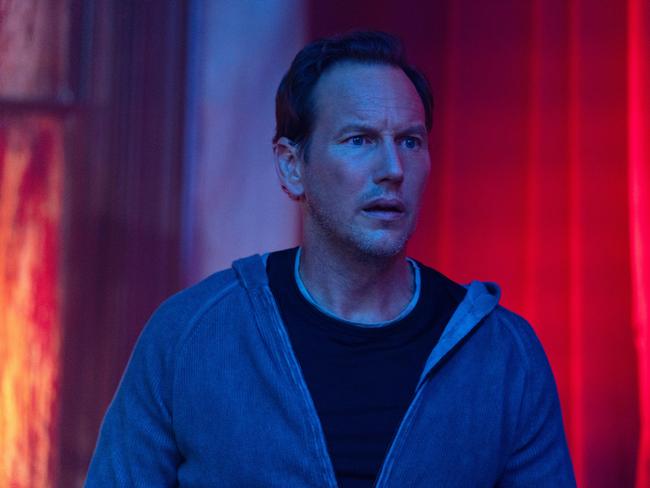Insidious: The Red Door, scarily bereft of originality
Australian filmmakers James Wan and Leigh Whannell have had considerable success in Hollywood with their bloody horror films. But it’s time to give the Insidious franchise a rest.

Insidious: The Red Door (M)
In cinemas
★★
Australian filmmakers James Wan and Leigh Whannell, who met while they were studying at Melbourne’s Institute of Technology Media Arts Course, have had considerable success in Hollywood where they have made a series of sometimes bloody horror films (Saw, The Conjurer). The team made the first film in the Insidious franchise, with Rose Byrne and Patrick Wilson, in 2010 and Insidious: The Red Door is the fifth in the series and the first directed by Wilson, making his debut behind the camera.
Not being a particular fan of these films — I prefer my horror to be far more subtle — I went to see the film without a great deal of enthusiasm.
On the plus side, The Red Door is well acted with a delightful contribution from Sinclair Daniel, a talented young African-American, who effectively plays the female lead.
MORE FILM REVIEWS: Mission: Impossible a must-see on the big screen | I’ve never understood the popularity of Carmen | Sarah Snook stars in new thriller … but young co-star steals the show
When the film begins Josh Lambert (Wilson) is separated from his wife, Renai (Rose Byrne). His eldest son, Dalton (Ty Simpkins) is heading off to college to study art and Josh, who hasn’t seen much of the young man in recent times, offers to drive him there (American colleges always seem to be a long way away from wherever it is you are living).
Soon father and son are being haunted by terrifying nightmares which seem to link back to past events. Dalton begins to work on a painting of a red door with a deranged, slobbering man wielding a hammer in front of it. Is this a reference to his own past where, as he tells Chris (Daniel), who becomes his closest friend, he was in a coma for a year when he was 10 years old? Josh, meanwhile, seeks medical help and one of the film’s scarier scenes has him encounter something very nasty while undergoing what appears to be a CT scan.
But overall the film doesn’t deliver much in the way of original horror (a painting by Goya shown as part of the art class is nastier than anything in the film itself). The screenplay, by Whannell and Scott Teems, has plenty of clunky dialogue (“You have no idea what you’re messing with”) and the moments of so-called horror invariably involve shock cuts to extras wearing weird makeup. When poor Dalton dreams/imagines that someone is vomiting all over his face it becomes clear that this is a film bereft of truly original ideas.
The work of Whannell and Wan used to be more surprising, even when it was borderline sadistic. But here they seem to be lacking inspiration. It’s time to give this franchise a rest.
-
Daliland (M)
In cinemas
★★★
Salvador Domingo Felipe Jacinto Dali I Domenech, Marquess of Dali and Pubol (1904-1989), better known as simply Salvador Dali, was one of the 20th century’s most influential artists and, for a while, his works were as sought after as those of his fellow countryman, Pablo Picasso.
Despite that flamboyant name, Dali’s father was a middle-class lawyer from the Catalan town of Figueres, where Dali was born. As a young man he became interested in classical art, especially the work of Velazquez, but he soon became attracted to cubism and surrealism. He was frequently controversial, deliberately pushing the boundaries of what was acceptable. He dabbled in film when, in Paris at the end of the 20s, he and another fellow countryman, Luis Bunuel, made the challenging Un chien Andalou (An Andalusian Dog) (1929) and L’age d’or (The Golden Age) (1930), both fine examples of surrealist cinema.
Director Mary Harron’s Daliland opens with an hilarious clip from a 1950s episode of the popular American TV show What’s My Line? in which the blindfolded members of the panel have to guess the identity of the celebrity guest, Dali. To every question asked of him the magnificently moustachioed Dali answers in the affirmative, regardless of whether or not what he says is true, but he was so famous at the time that it doesn’t take long for the panellists to identify him.
Nothing that follows is quite as riveting as this opening sequence. Harron, whose first film, I Shot Andy Warhol (1996), was about another very famous and very eccentric artist, has chosen to tell a story set in 1974, in Dali’s waning years, by which time he’d almost become a joke. He and his wife, Gala (Barbara Sukowa), are spending half the year living in a suite in New York’s St. Regis Hotel – which costs them $20,000 per month. I’d hoped for an original approach to Dali’s story, but the screenplay, by John C. Walsh, takes the easy option of allowing the viewer to enter “Daliland” via a naive outsider, James Linton (Christopher Briney). Tasked by the gallery that employs him to deliver a wad of cash to Gala, and warned that Dali’s wife is attracted to good looking young men, James enters this world of eccentrics, hustlers and hedonists.

Taking the viewer into Dali’s world through the innocent eyes of a stranger is a familiar device, and Harron doesn’t bring anything very fresh to this world of parties, debauchery and borderline criminality.
Ben Kingsley plays Dali and he’s splendid in the role. With his flowing locks, eccentric moustache and combination of confidence and uneasiness, Kingsley nails the character. Dali is uneasy because he has a new show coming up in a short space of time and he’s nowhere near ready. He’s distracted by the party atmosphere in the hotel and, although he seems not to take part in the sexual activities himself, he obviously likes to watch, especially Gala, whose latest young man is Jeff Fenholt (Zachary Nachbar-Seckel), a beautiful youth playing the title role in the Broadway production of Jesus Christ Superstar.
Dali, meanwhile, hires James – whom he calls San Sebastian – as his assistant and comes to rely on the young man. To finance his expensive lifestyle Dali must keep painting – and if he occasionally puts his signature to canvases that have not so far been painted, well that seems to be a normal thing in Daliland.
There are a couple of flashbacks to the early 1930s in which Ezra Miller plays the young Dali and Avital Lvova the young Gala. These scenes are intriguing, but I wished the film had also covered the period in which Dali worked with Alfred Hitchcock on the dream sequences for the psychological thriller, Spellbound (1945).
Ultimately there are dull patches in the film, scenes in which the activities of Dali and his entourage become rather repetitive. The film is worth seeing for Kingsley and Sukowa, who are both excellent, but it could have been more substantial.


To join the conversation, please log in. Don't have an account? Register
Join the conversation, you are commenting as Logout